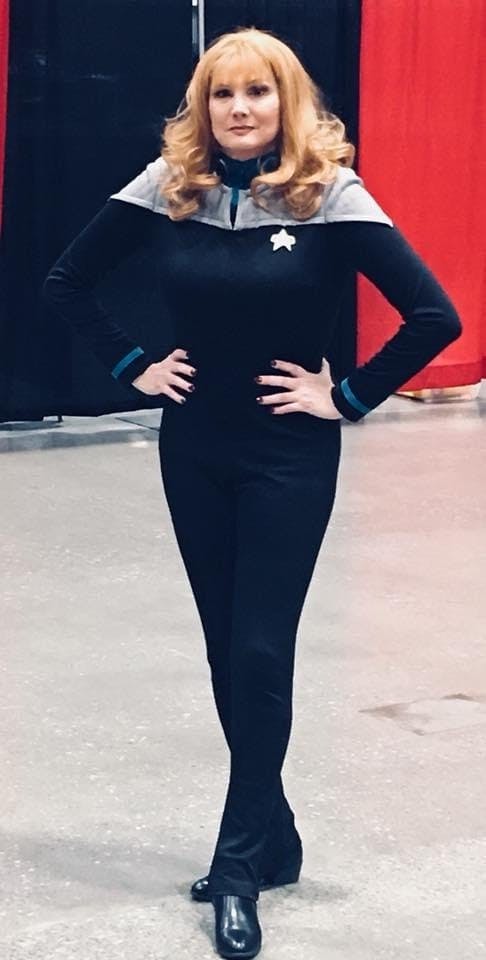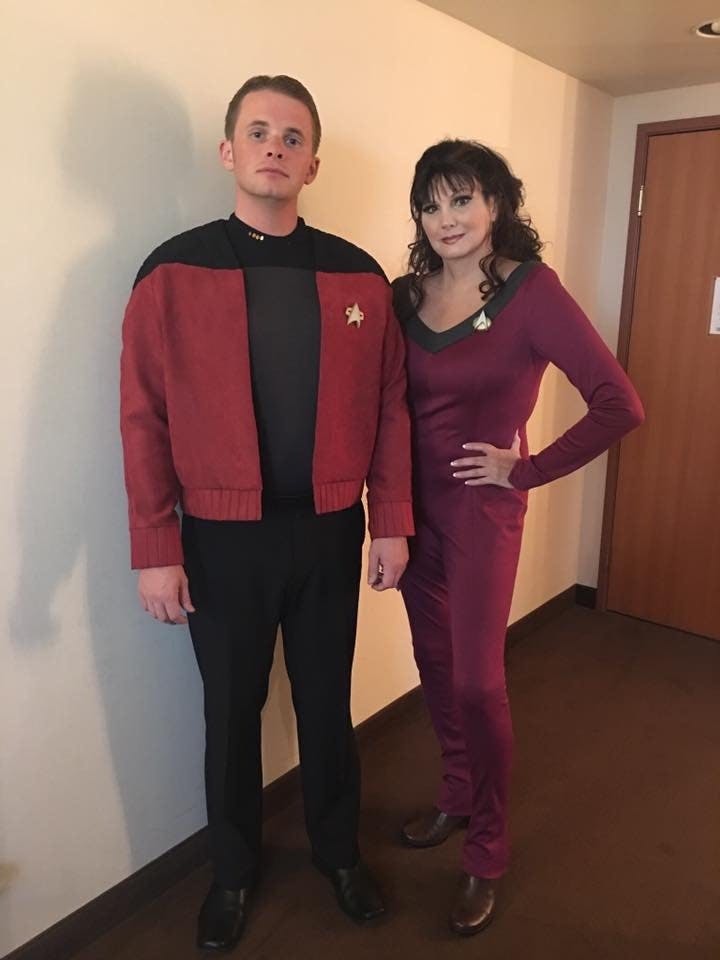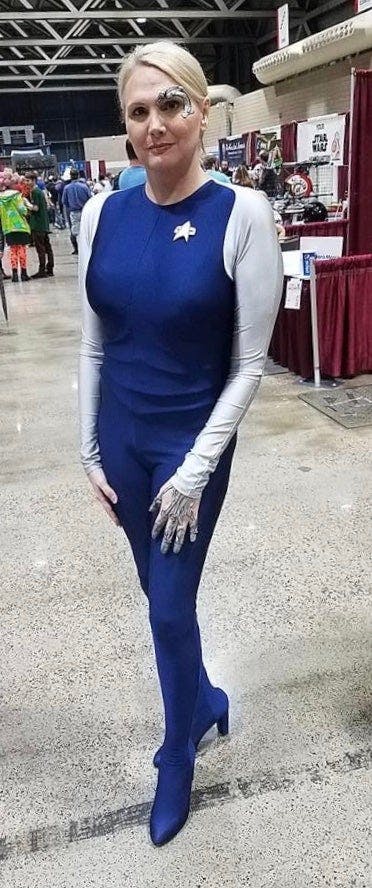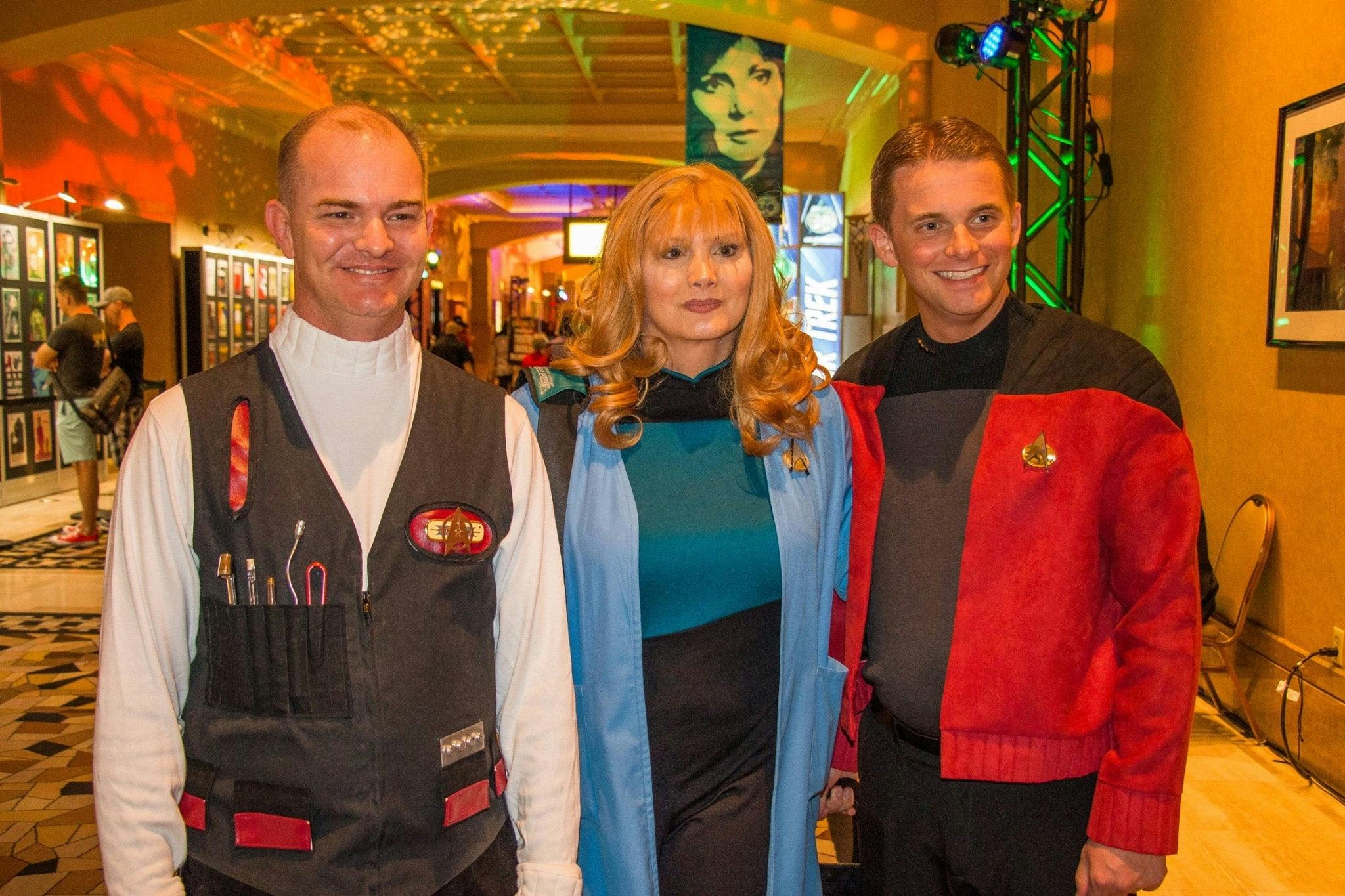Published Apr 15, 2020
The Evolution of Female Role Models in Star Trek
One fan shares her thoughts on the evolution of female characters in Trek.

StarTrek.com
A lifelong Star Trek fan who was born in 1968, Madison Spencer Engle kept a keen eye on the franchise’s portrayal of women as it gradually evolved over the past five decades. An avid cosplayer and a regular attendee at the annual Star Trek convention in Las Vegas, Madison has continued to observe the progress that Star Trek: Discovery and Star Trek: Picard have made on the road to equal representation.

StarTrek.com
Madison checked in with StarTrek.com to discuss her views on female role models, Seven of Nine’s return in Picard, technology’s relationship with our fandom, and much more.
StarTrek.com: Thanks for joining us, Madison. Do you recall how you were introduced to Star Trek?
Madison Spencer Engle: It was the early 1970s, and I was in the first grade. I clearly remember Star Trek being in afternoon reruns on Channel 41 where I grew up in Kansas City. The first episode I remember seeing was “The Galileo Seven,” and I had never seen anything like it. I vividly recall my reaction to Yeoman Mears throwing herself on the ground during liftoff for absolutely no reason. I thought it was the greatest piece of acting... ever! But, I was in first grade [laughs].
I watched another episode the next day and was hooked. I loved the idea of meeting aliens from different worlds and dreamed of being beamed up to the Enterprise. The strange worlds, the exotic costumes, and the customs... I loved everything that was different from my own little world. The little television in my bedroom brought me an incredible new universe. I continue to appreciate Uhura and her presence as a woman in leadership on the bridge.
What was your first impression of the way in which women were portrayed in the early Star Trek episodes that you watched?

StarTrek.com
MSE: In the early episodes, the female characters were often there to be rescued by a male officer. It was also how my childhood friends acted out the episodes - I was always the lieutenant in need of saving. Women were also bridge officers, nurses, ambassadors. They were much more than damsels in distress. They were represented in the workforce, very 1960s. Some of the female villains could be hyper-sexualized in their look yet cruel in their actions, an interesting duality.
I quickly felt a strong connection to Nurse Chapel. I think it was because she was a fellow blonde and a little pushy, yet she still tried to please her colleagues. As a child, I felt as if I was constantly trying to please my teachers at school, but somehow fell short. Chapel seemed a little sad, and I saw that in my younger self. As I grew older and re-watched, I connected more with Uhura’s positivity. She never gave up, and always kept trying to get through the subspace interference!
In your opinion, how did Star Trek’s depiction of female role models change as the franchise moved from the The Original Series’s time period into the The Next Generation era?
MSE: There had been a huge leap forward by The Next Generation in 1987. The stories were so strong and character-driven. We had two female bridge officers in Deanna Troi and Tasha Yar, as well as a chief medical officer in Beverly Crusher. These women were fully-developed characters - they were strong, capable, smart, and sexual, in addition to being gentle, loving, and nurturing. We saw female characters from varied species who embodied a plethora of unique traits.
As early as the first season, we witnessed examples of power and confidence. In “Angel One,” Troi took command of communicating with the new species, Crusher ordered Picard to his sick bed, and Riker was the object of sexual desire. This was a welcome change for my 20 year-old self! Season seven’s “Thine Own Self” depicts Dr. Crusher discussing why she chose to become a full commander with Troi. This felt like a beautiful commentary on working women and working mothers, that it can be done. Of course, who can forget Crusher being an outstanding captain in “Descent?”
Deep Space Nine gave us completely new types of female characters, especially in Kira and Dax. This was refreshing and exciting, because we were seeing women in even more dynamic roles. By the time Voyager came out, we finally had a female captain. Janeway brought something so new, so different, to the captain’s chair. It is always poignant to hear Kate Mulgrew talk about her first day on set, when she noticed all of the male executives watching and silently judging her ability to lead. I think we can all agree that she showed them how it’s done! She had all of the strength, wisdom, and experience, but her empathy felt different from the previous male captains.
Troi and Crusher seem to be two of your favorite characters to cosplay. What about those two The Next Generation leads makes portraying them so intriguing to you?

StarTrek.com
MSE: Dr. Crusher was the first character who I ever cosplayed, and I was quite deliberate in picking her. I wanted someone I enjoyed as a character whose age and body type were appropriate, as well as a character fans would know and like. She was an easy choice for me. Beverly is a wonderful representation of strong women in Star Trek. I chose Deanna Troi, frankly, because her costume pushed me out of my comfort zone. Her outfits have always been skin tight… no lab coat or jacket to hide in. I had to find my confidence and began walking down convention halls proudly. Cosplaying Troi gave me the confidence to go even further and create a Seven of Nine costume.
I have always been inspired by Marina Sirtis’s “take no prisoners” approach to life. She speaks her mind openly. I appreciate her humor on social media and at conventions. When I saw her hug Jean-Luc on Picard, I knew it was not acting. That was a genuine hug between best friends. Gates reminds me to relax and breathe. When I see her on social media and conventions, she exudes health and positivity. These women are different, but they bring humor and insight, whether it is discussing a Trek episode or other topics.
Was there ever a moment where you felt as if Star Trek briefly regressed in its attitudes towards women?
MSE: I was often uncomfortable with how T’Pol was utilized on Enterprise, primarily in the decontamination and Vulcan massage scenes. They always felt gratuitous and exploitive. This disappointed me, because I loved her as a character and wanted there to be more scenes featuring her strength and leadership, qualities she absolutely possessed.
What do you believe to be the most significant advances that Discovery has made in terms of representation?
MSE: With Discovery, it feels like the amount of female characters has really jumped! Tilly and Jett give us voices we have not heard before. Cornwell holds a very special place in my heart. To have a female character close to my age in a major leadership role on Star Trek was just fantastic. I feel it also inspires younger women to understand that they will not fade away as they get older, they can lead just like Cornwell. I wish we could have seen her more in Discovery, but of course no one is ever really gone is science fiction! She used her therapy background very well with Mirror Lorca and Hugh Culber, but she got to be “Admiral Badass” first and foremost! Jayne Brook is a truly classy and dignified woman, a real role model for women of all ages.
What has been your impression of the female role models on Picard?

StarTrek.com
MSE: With Picard, the female characters have more strength in their voice and presence. The motivations for Raffi, Soji, and Jurati are all so different. Then you add in Admiral Clancy and Narissa, and it’s a completely new energy. Of course, seeing Troi again was a much-needed emotional hug. I am planning to cosplay Admiral Clancy, I think she is just fantastic! Fans certainly have opinions on how she treated Jean-Luc. Love her or hate her, you cannot deny she has strength in her convictions and can tell why she's risen through the ranks to be C-in-C of Starfleet! It is great to see a woman in charge.
How did you feel about Seven of Nine’s return in Picard?
MSE: I was thrilled. I think many people wanted to know what happened to her after Voyager returned home, myself included. I think her difficult path needed to happen. Seven will always be one who travels a troubled highway. It’s nice to see she has not lost one nanometer of her spunk!
Social media plays a very prominent part in discussions surrounding the latest Star Trek series and the franchise itself. Is this a positive development?
MSE: Social media is only as positive as the person behind the keyboard. Anything can be used for negativity. I wish more fans spent their energy being positive towards one another and Star Trek as a whole online. I do like how it enables people who have never physically met to connect. Thanks to social media, I now have friends from multiple countries and am better for it. Being able to jump online and say hello to a friend in another state or another country is great. It’s good to be there for a birthday or special event, albeit virtually. There have been times I’ve been able to be there for a friend who was down. Something as simple as a little video message for a friend on the other side of the globe can do wonders.
Are there ways that you feel technology’s influence on fan conversations can be improved?

StarTrek.com
MSE: For me, it is simple. When having a passionate discussion, respect an opinion that is different from your own. I think of it like this: if you were face-to-face and not at a keyboard, would you really say that to a person? If not, then it’s best to leave it in your quarters. No room for it on the bridge, as Kirk would say.
Speaking of technology, you have taken part in Star Trek’s #PicardPrep tweet events. What did you think of those fan experiences?
MSE: I love doing them! I am grateful that Star Trek reached out to me and asked me to be a part of them on my @SpaceGeekGirl handle. I have met some new people on Twitter because of them, and I get to research episodes that I’ve watched for years without ever really stopping to think about. The “I, Borg” tweet session was my favorite so far. It was the first in the #PicardPrep series, and it was exciting to be a part of something new and inclusive to all fans. The tweet sessions help bring the fans together.
Let’s shift gears for our final question. What inspired you to begin cosplaying? How has the convention scene affected your perception of Star Trek fandom?
MSE: I have spent most of my life designing costumes for others and felt it was finally my turn. I started cosplaying for myself, because it just looked so fun. It is surreal to dress like your heroes. I knew I wanted to cosplay Dr. Crusher. She is one of my favorite characters and most importantly, her lab coat has pockets! Being a cosplayer in the Star Trek world has made me more aware of the work fans put in to resemble characters they admire. Fans know every tiny detail of these costumes, so I am always on my game to faithfully recreate these outfits while also making them my own. You are also asked to pose for photos, which I really enjoy. People can then go home and say they met Dr. Crusher! That makes it all worthwhile for me.
Jeri Ryan Answers a Fan's Question
Jay Stobie (he/him) is a freelance writer who contributes articles to the official Star Trek website and Star Trek Magazine, as well as to Star Wars Insider and the official Star Wars website. Jay also serves as a part-time assistant and consultant advising many actors and creatives who work on his favorite sci-fi shows and films. He can be found on Twitter and Instagram at @StobiesGalaxy.

